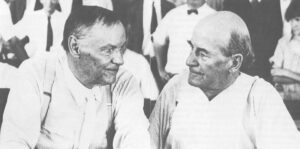Rita Ciolli
- 1983

Fellowship Title:
- Book Banning and Revisions and Changes in Textbooks in America
Fellowship Year:
- 1983

The Monkey Trial: Round Two
“It is bigotry for the public schools to teach one theory of origin.” The words aren’t from prosecutor William Jennings Bryan, but from defense counsel Clarence Darrow. He made the argument in 1925 during the famous Scopes’ “Monkey Trial.” Clarence Darrow and William Jennings Bryan Photo Credit: WIDE WORLD PHOTOS And almost 60 years later, Darrow’s statement has become the rallying cry of his opponents. Creationists want equal time. It took the creationists six decades, but the cycle now seems complete. A critical case in Louisiana–which is destined for the U.S. Supreme Court–is shaping up as a more sophisticated replay of the 1920’s battle provoked by Charles Darwin’s theory of evolution. Although a trial will not take place in New Orleans until late summer or early fall of this year, millions of dollars have already been spent for legal fees and expenses. The disputed law survived a major legal challenge in late 1983. The federal court challenge on the First Amendment issues of separation of church and state and academic freedom was postponed until the

The Politics of Textbooks
AUSTIN, Texas–Chapter 25 of “World History, Our Common Heritage” deals with the industrial revolution. Understandably, it’s devoted mostly to the influence of Karl Marx. And it’s illustrated with pictures of four people. Florence Nightingale. Elizabeth Fry. Charlotte Bronte. Ludwig von Beethoven. Marx’s impact couldn’t be ignored. But since Marx’s socialistic message rivals only Charles Darwin’s theory of evolution in generating controversy, his powerful image could be left out to soften the blow. In its place would be substituted pictures of three non-threatening women. This would satisfy the feminists, who keep running tallies of gender illustrations. And it wouldn’t disturb the Daughters of the American Revolution, either. A publisher can’t get safer than Florence Nightingale. The textbook, published by Ginn, was not unique among the eleven world history books under consideration for use in grades 9 through 12 in Texas high schools. Only five books contained a picture of Marx. But this book–and the way it was selected for Texas schools last summer–are symbolic of what is happening in the nation’s $1 billion-plus textbook industry. Ever

Thought Control
Jake is one of the Depression era’s unemployed. He owns an ornery mule named Honeybunch. One day the mule dawdles while they’re crossing the railroad tracks. Jake and Honeybunch get hit by the train. They go to heaven. The pair arrive in the clouds to find a bearded, black God with a star-studded bow tie who presides over a celestial barbecue of chicken and ribs. A jazz band is entertaining the faithful. But the unlucky Jake puts on two left wings by mistake and causes such havoc flying around that he’s thrown out of the pearly gates. The story ends happily when Jake, reinstated because of the antics of the crazy mule, is rewarded with the job of hanging out the moon and stars each night. Jake and Honeybunch Go To Heaven by Margot Zemach is a 34-page children’s book. It contains pastel, Chagall-like drawings. And it’s one of the most controversial and censored books in the nation. Library systems in the cities of San Francisco, Chicago and Milwaukee have refused to purchase the book,
